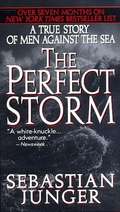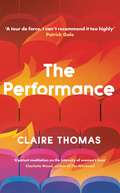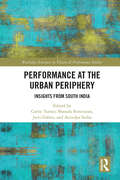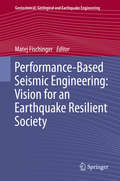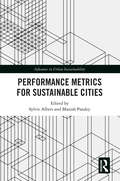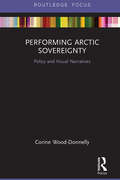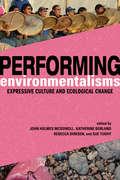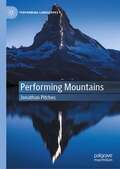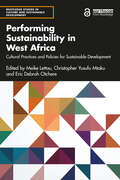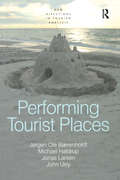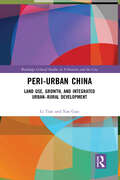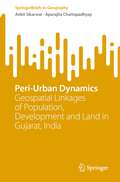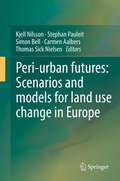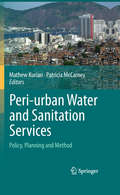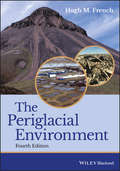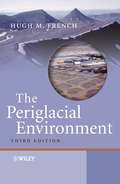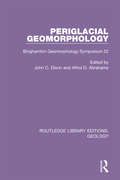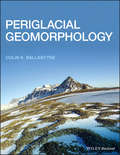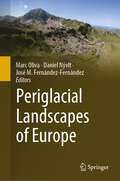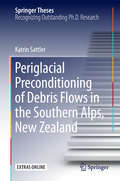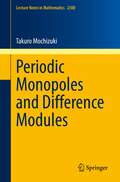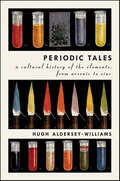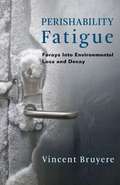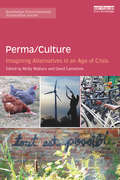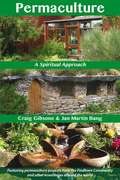- Table View
- List View
The Perfect Storm: A True Story of Men Against the Sea
by Sebastian JungerThe bestselling book that became the blockbuster film starring George Clooney, Mark Wahlberg, and Diane Lane.<P> In October 1991, three weather systems collided off the coast of Nova Scotia to create a storm of singular fury, boasting waves over one hundred feet high. Among its victims was the Gloucester, Massachusetts-based swordfishing boat the Andrea Gail, which vanished with all six crew members aboard.<P> "Drifting down on swimmers is standard rescue procedure, but the seas are so violent that Buschor keeps getting flung out of reach. There are times when he's thirty feet higher than the men trying to rescue him. . . . [I]f the boat's not going to Buschor, Buschor's going to have to go to it. SWIM! they scream over the rail. SWIM! Buschor rips off his gloves and hood and starts swimming for his life."<P> It was the storm of the century, boasting waves over one hundred feet high a tempest created by so rare a combination of factors that meteorologists deemed it "the perfect storm." When it struck in October 1991, there was virtually no warning. "She's comin' on, boys, and she's comin' on strong," radioed Captain Billy Tyne of the Andrea Gail off the coast of Nova Scotia, and soon afterward the boat and its crew of six disappeared without a trace. <P> In a book taut with the fury of the elements, Sebastian Junger takes us deep into the heart of the storm, depicting with vivid detail the courage, terror, and awe that surface in such a gale. Junger illuminates a world of swordfishermen consumed by the dangerous but lucrative trade of offshore fishing, "a young man's game, a single man's game," and gives us a glimpse of their lives in the tough fishing port of Gloucester, Massachusetts; he recreates the last moments of the Andrea Gail crew and recounts the daring high-seas rescues that made heroes of some and victims of others; and he weaves together the history of the fishing industry, the science of storms, and the candid accounts of the people whose lives the storm touched, to produce a rich and informed narrative. The Perfect Storm is a real-life thriller that will leave readers with the taste of salt air on their tongues and a sense of terror of the deep.
The Performance: A Novel
by Claire Thomas'Quietly transformational'The Times 'A tour de force... I can't recommend this too highly'Patrick Gale'Innovative... an original, at-a-sitting read'Daily Mail'A potent meditation on the intensity of women's lives'Charlotte Wood, author of The Weekend'A miracle... Engaging and evocative'Washington Post'I loved and admired The Performance... Unmissable'Emma Stonex, author of The Lamplighters'Lively and intimate... The way Thomas plays with the reader is a sort of genius'Guardian'Thomas writes these women with such wisdom and compassion, that by the end we are all transformed'Claire Fuller, author of Unsettled Ground The false cold of the theatre makes it hard to imagine the heavy wind outside in the real world, the ash air pressing onto the city from the nearby hills where bushfires are taking hold.The house lights lower.The auditorium feels hopeful in the darkness.As bushfires rage outside the city, three women watch a performance of a Beckett play.Margot is a successful professor, preoccupied by her fraught relationship with her ailing husband. Ivy is a philanthropist with a troubled past, distracted by the snoring man beside her. Summer is a young theatre usher, anxious about the safety of her girlfriend in the fire zone.As the performance unfolds, so does each woman's story. By the time the curtain falls, they will all have a new understanding of the world beyond the stage.
Performance at the Urban Periphery: Insights from South India (Routledge Advances in Theatre & Performance Studies)
by Anindya Sinha Cathy Turner Jerri Daboo Sharada SrinivasanThis edited volume considers performance in its engagement with expanding Indian cities, with a particular focus on festivals and performances in Karnataka, Tamil Nadu and Kerala. The editors ask how performance practices are affected by urbanisation, the effects of such changes on their cultural economy, and the environmental impacts of performance itself. This project also considers how performance responds to its context, and the potential for performance to be critical of the city’s development, and of its own compromises. Bringing together perspectives from the humanities, natural and social sciences, the book takes a multi-faceted analytical view of live performance, connecting contemporary with heritage forms, and human with more-than-human actors. The three sections, themed around heritage, everyday life, and future ecologies, will be of great interest to students and scholars in performance, heritage studies, ecology and art history.
Performance-Based Seismic Engineering: Vision for an Earthquake Resilient Society
by Matej FischingerThe Bled workshops have traditionally produced reference documents providing visions for the future development of earthquake engineering as foreseen by leading researchers in the field. The participants of the 2011 workshop built on the tradition of these events initiated by Professors Fajfar and Krawinkler to honor their important research contributions and have now produced a book providing answers to crucial questions in today's earthquake engineering: "What visible changes in the design practice have been brought about by performance-based seismic engineering? What are the critical needs for future advances? What actions should be taken to respond to those needs?" The key answer is that research interests should go beyond the narrow technical aspects and that the seismic resilience of society as a whole should become an essential part of the planning and design process. The book aims to provide essential guidelines for researchers, professionals and students in the field of earthquake engineering. It will also be of particular interest for all those working at insurance companies, governmental, civil protection and emergency management agencies that are responsible for assessing and planning community resilience. The introductory chapter of the book is based on the keynote presentation given at the workshop by the late Professor Helmut Krawinkler. As such, the book includes Helmut's last and priceless address to the engineering community, together with his vision and advice for the future development of performance-based design, earthquake engineering and seismic risk management.
Performance Metrics for Sustainable Cities (Advances in Urban Sustainability)
by SylvieManish Albert PandeyPerformance Metrics for Sustainable Cities provides an overview of measurement systems and tools to enable communities to self-assess and benchmark their progress along a continuum of smart, intelligent, and sustainable development. It begins by explaining the importance of measurement and evaluation for cities and smaller communities, as well as future factors that will need to be considered and embedded into planning processes. Across 14 chapters, the book describes existing evaluation mechanisms that are being used for government funding decisions, awards of recognition, and new measurement systems to assess what makes a city smarter and more sustainable, such as broader sustainable goal targets (UN SDGs), green cities, fabrication cities, and compassionate cities. It presents examples of metrics used for important sustainability and liveability concepts for cities such as how to measure trust, engagement, compassion, circular economy, and so forth. The book ends with reflections on the feasibility of a holistic system of measurement and the implications of its implementation. This volume will be of great interest to students, researchers, and professionals of urban sustainability, planning, smart cities, and sustainable communities.
Performing Arctic Sovereignty: Policy and Visual Narratives (Routledge Research in Polar Regions)
by Corine Wood-DonnellyThe Arctic is 5.5 million square miles and has been inhabited by humans for thousands of years, yet it is still a frontier of development. But who owns the Arctic? This book charts the history of performances of sovereignty over the Arctic in the policy and visual representations of the US, Canada and Russia. Focusing on narratives of the effective occupation of territory found in postage stamps, it offers a novel analysis of Arctic sovereignty. Issues such as climate change, plastics pollution and resource development continue to impact the future of this space centred around the North Pole. Who is responsible for the region? This book examines how countries have absorbed Arctic territory into their national consciousness, examining the choice of, and use of, symbols and images in postage stamps. It looks at the story of how these countries have represented their Arctic frontiers and territorial peripheries. The book argues that the performance of policy in these regions has caused relative sovereignty to become a reality. It provides an intriguing account of how these countries have, in their distinctive ways, established, legitimised and reinforced their political authority in these regions. This book will appeal to Geographers and is recommended supplementary reading for students in political history and regional studies of the North.
Performing Environmentalisms: Expressive Culture and Ecological Change
by Aaron S. Allen Eduardo S Brondizio Assefa Tefera Dibaba Rebecca Dirksen Mary Hufford John Holmes McDowell Mark Pedelty Jennifer C. Post Chie Sakakibara Jeff Todd Titon Rory Turner Lois WilckenPerforming Environmentalisms examines the existential challenge of the twenty-first century: improving the prospects for maintaining life on our planet. The contributors focus on the strategic use of traditional artistic expression--storytelling and songs, crafted objects, and ceremonies and rituals--performed during the social turmoil provoked by environmental degradation and ecological collapse. Highlighting alternative visions of what it means to be human, the authors place performance at the center of people's responses to the crises. Such expression reinforces the agency of human beings as they work, independently and together, to address ecological dilemmas. The essays add these people's critical perspectives--gained through intimate struggle with life-altering force--to the global dialogue surrounding humanity's response to climate change, threats to biocultural diversity, and environmental catastrophe. Interdisciplinary in approach and wide-ranging in scope, Performing Environmentalisms is an engaging look at the merger of cultural expression and environmental action on the front lines of today's global emergency. Contributors: Aaron S. Allen, Eduardo S. Brondizio, Assefa Tefera Dibaba, Rebecca Dirksen, Mary Hufford, John Holmes McDowell, Mark Pedelty, Jennifer C. Post, Chie Sakakibara, Jeff Todd Titon, Rory Turner, Lois Wilcken
Performing Mountains (Performing Landscapes)
by Jonathan PitchesLaunching the landmark Performing Landscapes series, Performing Mountains brings together for the first time Mountain Studies and Performance Studies in order to examine an international selection of dramatic responses to mountain landscapes. Moving between different registers of writing, the book offers a critical assessment of how the cultural turn in landscape studies interacts with the practices of environmental theatre and performance. Conceived in three main parts, it begins by unpicking the layers of disciplinary complexity in both fields, before surveying the rich history and practice of rituals, playtexts and site specific works inspired by mountains. The last section moves to a unique analysis of mountains themselves using key concepts from performance: training, scenography, acting and spectatorship. Threaded throughout is a very personal tale of mountain research, offering a handrail or alternative guide through the book.
Performing Sustainability in West Africa: Cultural Practices and Policies for Sustainable Development (Routledge Studies in Culture and Sustainable Development)
by Meike Lettau, Christopher Yusufu Mtaku and Eric Debrah OtchereThis book discusses the role of cultural practices and policy for sustainable development in West Africa across different artistic disciplines, including performance, video, theatre, community arts and cultural heritage. Based on ethnographic field research in local communities, the book presents findings on current debates of cultural sustainability in Nigeria, Ghana, Cameroon and Benin. It provides a unique perspective connecting cultural studies, conflict studies and practical peacebuilding approaches through the arts. The first part pays particular attention to aspects of social cohesion and the circumstances of internally displaced persons e. g. caused by the Boko Haram insurgency in Northeast Nigeria. The second part focuses on cultural policy issues and challenges in the context of sustainable development, investigating participatory approaches and bottom-up processes, the role of governments and civil society, as well as performing arts organizations and universities in policy making and implementation processes. Performing Sustainability in West Africa presents research results and new methods on the role of artistic and cultural practices in conflict situations as well as current debates in cultural policy for researchers, academics, NGOs and students in cultural studies, sustainable development studies and African studies.
Performing Tourist Places (New Directions in Tourism Analysis)
by John Urry Jørgen Ole Bærenholdt Michael HaldrupThis book looks at the making and the consuming of places in the contemporary world. Illustrated through various case-studies from Denmark, it considers how places, performances and peoples intersect. It examines the fascinating circumstances through which visitors to a place, in part, produce that place through their performances. Places are intertwined with people through various systems that generate and reproduce performances in and of that place. These systems comprise networks of ’hosts, guests, buildings, objects and machines’ that contingently realize particular performances of specific places. The studies featured here develop an exciting ’new mobility’ paradigm emerging within the social sciences.
Peri-Urban China: Land Use, Growth, and Integrated Urban–Rural Development (Routledge Critical Studies in Urbanism and the City)
by Yan Guo Li TianThe urban-rural relationship in China is key to a sustainable global future. This book is particularly interested in peri-urbanization in China, the process by which fringe areas of cities develop. Recent institutional change has helped clarify property rights over collective land, facilitating peri-urban area development. Chapters in this book explore how rural industrialization has changed the landscape and rules about land use in peri-urban areas. It looks at the role of rural industrialization and provides a detailed exploration of peri-urbanization theory, policy, and its evolution in China. Leading discussions find out how fragmented bottom-up industrialization, urbanization, and lax governance have led to a series of social and environmental problems. The progress in redevelopment of peri-urban areas was initially slow due to the spatial lock-in effect. This book offers practical solutions to environmental issues and explains how policymakers have the potential to redevelop a future collaborative, inclusive, and sustainable approach to peri-urban areas. This in-depth approach to urbanization will be useful to academics in urban planning and governmental organizations. It will also be advantageous to NGOs and professionals involved in urban planning, public administration, as well as land-use work in China and other developing countries.
Peri-Urban Dynamics: Geospatial Linkages of Population, Development and Land in Gujarat, India (SpringerBriefs in Geography)
by Ankit Sikarwar Aparajita ChattopadhyayUrban expansion beyond the city’s administrative boundaries has altered villages to a great extent. These peri-urban villages are experiencing unforeseen changes in demographic, economic, land-use, and environmental characteristics. The concept of peri-urbanization is grabbing the attention of urban planners and policymakers globally. To understand the dynamics of the peri-urban region it is crucial to examine multiple rural and urban characteristics. This book studies major changes in population, land and development with the integration of remotely sensed data and census data for 615 peri-urban villages surrounding Ahmedabad city of India. The chapters of the book are designed to cover key aspects of peri-urban change with geospatial methods. This book offers a comprehensive understanding and importance of analyzing peri-urban dynamics at the smallest spatial unit. It provides a detailed conceptual and methodological framework for the students and researchers to study peri-urbanization as well as for the policymakers to redefine the urban policies.
Peri-urban futures: Scenarios and models for land use change in Europe
by Carmen Aalbers Kjell Nilsson Simon Bell Stephan Pauleit Thomas A. Sick NielsenPresently, peri-urbanisation is one of the most pervasive processes of land use change in Europe with strong impacts on both the environment and quality of life. It is a matter of great urgency to determine strategies and tools in support of sustainable development. The book synthesizes the results of PLUREL, a large European Commission funded research project (2007-2010). Tools and strategies of PLUREL address main challenges of managing land use in peri-urban areas. These results are presented and illustrated by means of 7 case studies which are at the core of the book. This volume presents a novel, future oriented approach to the planning and management of peri-urban areas with a main focus on scenarios and sustainability impact analysis. The research is unique in that it focuses on the future by linking quantitative scenario modeling and sustainability impact analysis with qualitative and in-depth analysis of regional strategies, as well as including a study at European level with case study work also involving a Chinese case study.
Peri-urban Water and Sanitation Services
by Mathew Kurian Patricia MccarneyMore than 2.6 billion people in the developing world lack access to safe water and sanitation service. The Millennium Development Goal's (MDG) target is to halve the number of people without access to a sustainable source of water supply and connection to a sewer network by 2015. That target is unlikely to be met. If there is anything that can be learnt from European experience it is that institutional reform occurs incrementally when politically enfranchised urban populations perceive a threat to their material well-being due to contamination of water sources.
The Periglacial Environment
by Hugh M. FrenchThe Periglacial Environment, Fourth Edition, is an authoritative overview of the world’s cold, non-glacial environments. First published in 1976 and subsequently revised in 1996 and 2007, the text has been the international standard for nearly 40 years. The Fourth Edition continues to be a personal interpretation of the frost-induced conditions, geomorphic processes and landforms that characterize periglacial environments. Part One discusses the periglacial concept and describes the typical climates and ecosystems that are involved. Part Two describes the geocryology (permafrost science) associated with frozen ground. Part Three outlines the weathering and geomorphic processes associated with cold-climate conditions. Part Four provides insight into the periglacial environments of the Quaternary, especially the Late Pleistocene. Part Five describes some of the problems associated with human occupancy in regions that experience frozen ground and cold-climate conditions. Extensively revised and updated Written by an expert with over 50 years of field research Draws upon the author’s personal experience from Northern Canada, Alaska, Siberia, Tibet, Antarctica, Svalbard, Scandinavia, southern South America, Western Europe and eastern North America This book is an invaluable reference for advanced undergraduates in geography, geology, earth sciences and environmental sciences programs, and to resource managers and geotechnical engineers interested in cold regions.
The Periglacial Environment
by Hugh M. FrenchThe Periglacial Environment, Third Edition, provides an authoritative overview of the world???s cold, non-glacial environments. Emphasis is placed upon the North American and Eurasian polar lowlands, but examples are also drawn from Antarctica, the Qinghai-Xizang (Tibet) Plateau, and the northern mid-latitudes. First published in 1976 and subsequently revised in 1996, the text has been the international standard for??over 30 years.The Third Edition continues to be a personal interpretation of the frost-induced conditions, geomorphic processes, and landforms that typify periglacial environments. The text is divided into four parts. Part One discusses the periglacial concept and its interactions with geomorphology, geocryology and Quaternary science. It also outlines the range and variability of periglacial climates and the degree to which??landscapes are in geomorphic equilibrium with prevailing periglacial conditions. Part Two describes present-day terrain that is either underlain by permafrost or experiencing intense frost action. The roles played by cryogenic weathering, ground ice, mass wasting, running water, wind action, snow and ice, and coastal processes are systematically analysed. Part Three summarizes evidence for the existence of periglacial conditions during the cold periods of the Pleistocene, with special reference to the mid-latitudes of Europe and North America. Part Four illustrates the geotechnical problems associated with human activity and resource development in periglacial environments, and discusses the potential impact of global climate change in the northern high latitudes.This excellent textbook is an invaluable resource for second and third year undergraduate students of Physical Geography, Geology, Environmental Science and Earth Science. The Periglacial Environment, Third Edition is also an??informative reading for professionals, researchers and lecturers working and teaching in the field.
Periglacial Geomorphology: Binghamton Geomorphology Symposium 22 (Routledge Library Editions: Geology #25)
by Abrahams John C. Dixon Athol D.This book, first published in 1992, contains the proceedings of the 22nd Binghamton Geomorphology Symposium, and highlights the quantity and diversity of periglacial geomorphic research being undertaken in Arctic and alpine environments. The articles explore a variety of geomorphic processes and examine the potential impacts of global change on the nature and extent of permafrost and seasonal ice phenomena.
Periglacial Geomorphology
by Colin K. BallantyneA fascinating and informative exploration of periglacial processes, past and present, and their role in landscape evolution Periglacial Geomorphology presents a comprehensive introduction to the processes that operate in present periglacial environments and discusses the inferences that can be drawn about former periglacial environments from those processes. Organized into six parts, the book opens with the historical and scientific context of periglacial geomorphology and the nature of periglacial environments. Following chapters provide systematic coverage of the full range of topics germane to a thorough understanding of periglacial geomorphology, including: The physics of ground freezing and thawing, characteristics of permafrost, and the nature and origin of underground ice Characteristics, formation and significance of landforms, sediments, and structures associated with permafrost, permafrost degradation, and seasonal ground freezing and thawing Rock weathering in periglacial environments, periglacial processes operating on hillslopes, and the characteristic landforms produced by rock breakdown and slope processes in cold environments The operation of fluvial, aeolian and coastal processes in cold environments, and the resulting distinctive landforms and sediments The use of relict periglacial features to reconstruct past cold environments in midlatitude regions and the responses of periglacial environments to recent and predicted climate change Periglacial Geomorphology is an important resource for undergraduate and graduate students studying geomorphology or Quaternary science within the context of geography and geology degree programs. It will be of use to all scientists whose research involves an understanding of cold environments, whether from a geographical, geological, ecological, climatological, pedological, hydrological, or engineering perspective.
Periglacial Landscapes of Europe
by Marc Oliva Daniel Nývlt José M. Fernández-FernándezThis book comprehensively presents the geography of landforms linked to periglacial processes across Europe. The landscape of the European cold climate regions, both at high latitudes and in mountainous environments, represent the lingering, minimal expression of the glaciers. In addition, periglacial elements can be found in temperate regions, where temperatures no longer favor periglacial processes, so landforms are therefore inherited from previous cold phases.The book is divided into five parts: an introductory section on climate variability responsible for periglacial dynamics across Europe; a second part including 3 blocks on periglacial landforms in southern, central and northern Europe; and a final chapter providing a more general perspective on the impact of periglacial processes on the landscape of Europe. The book offers a valuable reference guide for scientists from all disciplines interested in cold climate processes, as well as readers outside academia (territorial managers, environmentalists, mountaineers, politicians, engineers, etc.).
Periglacial Preconditioning of Debris Flows in the Southern Alps, New Zealand
by Katrin SattlerThis thesis represents one of the few studies so far that systematically analyses environmental conditions within debris flow source areas to determine their relative importance for debris flow development. Environmental site conditions, such as slope gradient and debris availability, influence the spatial and temporal distribution of debris flows in high-alpine areas. However, current understanding of these preconditioning controls is mostly qualitative and inadequate for debris-flow hazard assessments and climate change impact studies. The author's research investigates the role of frost weathering and permafrost in the occurrence of debris flows in the Southern Alps of New Zealand. Analyses are based on an extensive debris flow inventory, documenting debris flow occurrence and activity over the last 60 years in selected catchments. Debris flow activity is compared to frost-weathering intensity estimates from two models, allowing the practical comparison of two competing frost-weathering hypotheses currently discussed in literature. Information on permafrost occurrence is based on a new distributed permafrost estimate for the Southern Alps, derived from climatic conditions at active rock glacier sites. This pioneering thesis provides empirical evidence that frost weathering promotes debris-flow formation. It further highlights the potential and limitations of regional-scale studies for advancing our understanding of debris-flow preconditioning factors.
Periodic Monopoles and Difference Modules (Lecture Notes in Mathematics #2300)
by Takuro MochizukiThis book studies a class of monopoles defined by certain mild conditions, called periodic monopoles of generalized Cherkis–Kapustin (GCK) type. It presents a classification of the latter in terms of difference modules with parabolic structure, revealing a kind of Kobayashi–Hitchin correspondence between differential geometric objects and algebraic objects. It also clarifies the asymptotic behaviour of these monopoles around infinity.The theory of periodic monopoles of GCK type has applications to Yang–Mills theory in differential geometry and to the study of difference modules in dynamical algebraic geometry. A complete account of the theory is given, including major generalizations of results due to Charbonneau, Cherkis, Hurtubise, Kapustin, and others, and a new and original generalization of the nonabelian Hodge correspondence first studied by Corlette, Donaldson, Hitchin and Simpson.This work will be of interest to graduate students and researchers in differential and algebraic geometry, as well as in mathematical physics.
Periodic Tales: A Cultural History of the Elements, from Arsenic to Zinc
by Hugh Aldersey-WilliamsIn the spirit of A Short History of Nearly Everything comes Periodic Tales. Award-winning science writer Hugh Andersey-Williams offers readers a captivating look at the elements—and the amazing, little-known stories behind their discoveries. Periodic Tales is an energetic and wide-ranging book of innovations and innovators, of superstition and science and the myriad ways the chemical elements are woven into our culture, history, and language. It will delight readers of Genome, Einstein’s Dreams, Longitude, and The Age of Wonder.
Perishability Fatigue: Forays Into Environmental Loss and Decay (Critical Life Studies)
by Vincent BruyereThe Svalbard Global Seed Vault project is an arctic archive designed to preserve the world’s agricultural biodiversity. What do it and other novel forms of storage tell us about our relationship to the future in a time of resource depletion and extinction scenarios? In this innovative book, Vincent Bruyere offers an invitation to look at the present we live in through a fresh lens: the difference between storage and burial in the age of sustainability science.Perishability Fatigue considers questions of permanence and the potentiality of retrieval, noting the tensions within our collective sense of time and finitude. Bruyere reflects on the nature and significance of perishability, asking what it means to have one’s sense of temporality engendered by seed banks and frozen embryo storage, genetically modified organisms and the “de-extinction” of species, nuclear-waste repositories, oncology, and palliative care. He draws attention to the scripts and scenarios that mediate our relations to loss and decay, preservation and conservation, emphasizing the inequalities implicit in technologies of perishability, which promise continuity in the future to some while refusing it to others. A highly interdisciplinary study, Perishability Fatigue reframes the environmental humanities and humanistic inquiry into sustainability science by developing a new language to commemorate fatigue and transience in a culture of preparedness and survival.
Perma/Culture: Imagining Alternatives in an Age of Crisis (Routledge Environmental Humanities)
by Molly Wallace and David CarruthersIn the face of what seems like a concerted effort to destroy the only planet that can sustain us, critique is an important tool. It is in this vein that most scholars have approached environmental crisis. While there are numerous texts that chronicle contemporary issues in environmental ills, there are relatively few that explore the possibilities and practices which work to avoid collapse and build alternatives. The keyword of this book’s full title, 'Perma/Culture,' alludes to and plays on 'permaculture', an international movement that can provide a framework for navigating the multiple 'other worlds' within a broader environmental ethic. This edited collection brings together essays from an international team of scholars, activists and artists in order to provide a critical introduction to the ethico-political and cultural elements around the concept of ‘Perma/Culture’. These multidisciplinary essays include a varied landscape of sites and practices, from readings from ecotopian literature to an analysis of the intersection of agriculture and art; from an account of the rewards and difficulties of building community in Transition Towns to a description of the ad hoc infrastructure of a fracking protest camp. Offering a number of constructive models in response to current global environmental challenges, this book makes a significant contribution to current eco-literature and will be of great interest to students and researchers in Environmental Humanities, Environmental Studies, Sociology and Communication Studies.
Permaculture: A Spiritual Approach
by Craig Gibsone Jan Martin BangPermaculture design as divine creative activity. Permaculture looks for the patterns embedded in our natural world as inspirations for designing solutions to the many challenges we are presented with today. It is a philosophical, spiritual and practical approach to the use of the land, integrating microclimate, functional plants, animals, soils, water management and human needs into intricately connected, highly productive systems. In essence, permaculture uses observation as basis for creating sustainable and effective human settlements. The authors discuss the components Earthshare, Fairshare and Peoplecare, with a specific emphasis on the spiritual aspects of the design process. Topics range from soil and plants, energy sources and house design to alternative economics, group process, governance, and spiritual nurturing and enquiry. Examples of existing permaculture structures from around the world, most notably from the Findhorn Community Eco-Village, bring the concepts to life. First-hand accounts of how people got started on their permaculture project lend a personal touch. The first book to look at the spiritual aspects as well as the practical implementation of permaculture design.
